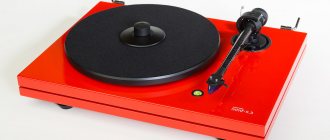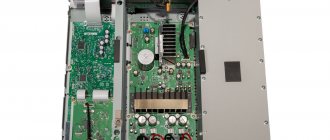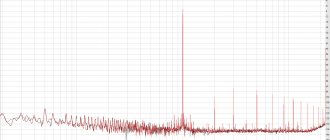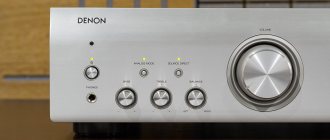In the relaunched line of Technics turntables, this model ranks second from top among the home models, rather than the limited-edition professional models. The only older ones are the very expensive SL-1000R turntable or the identical SP-10R phonomotor, sold without a housing and without tonearms.
However, the 1000 series is not yet supplied to Russia, so the SL-1200G can be considered our local “top”. So we’ll study it, including for correlations with the manufacturer’s past achievements.
Externally, this player is very similar to the entire 1200 series, but in reality it has a number of significant differences. However, this device is positioned as a completely domestic, home model, belonging to the pre-top line of “Grand Class” equipment. The device has incorporated a variety of features and characteristics: both independent or more similar to the 1000th top, and borrowed from professional Technics models.
Technics SL-1200G
At the first acquaintance, it becomes clear that the device is much more significant than its relatives. The manufacturer indicates a weight of 18 kg - despite its outwardly modest dimensions, this is impressive. The bulk falls on the table. The top panel of the player is a really solid aluminum panel, rather than plastic with an overlay. The main components of the player are attached to it - the motor, tonearm, electronics.
Even for partial disassembly of the Technics SL-1200G, you will need to unscrew several dozen different types of screws, but first, the large adjustable legs. They are unscrewed from a massive bottom made of plastic with impressive rubber damping. The legs are not connected to the rest of the table.
Having removed the legs and the first bottom, we see that the entire structure is then covered with a casing made of thick hard plastic. A few more screws and it too can be removed. Now let's look at the cast aluminum top plate, the mounting of the motor, which itself is entirely located above, the control electronics and a view of the tonearm from below.
The Technics SL-1200G disc with a top brass plate is not just put on the pulley, but also fixed with screws
The power supply of the device is switching - here its multi-voltage nature becomes clear. It looks like all the electronic stuffing here is its own - it doesn’t look like the insides of, for example, the Technics SL-1500C. There is partial similarity in the implementation of the power supply, but otherwise these are different boards.
The same can be said for engine management. The digital circuit, according to the manufacturer, is partially borrowed from the rotation stabilization systems of Blu-Ray players. Otherwise, everything is logical for such a device: a motor with a sensor, a control and feedback system. I note that according to the indicators that I was able to check, the drive is indeed very stable.
Technics SL-1200G with disk removed
Functionality: three rotation speeds, including 78 revolutions, switchable dual-range (±8%, ±16%) pitch, backlight and strobe. Nothing else is provided. Among the unusual functions: the ability to adjust the “behavior” of the motor - start speed and electronic brake.
There are two start and brake modes: factory programmed and manual. Personally, I would prefer to set both parameters to the slowest positions, because speed at home is not critical, and unnecessary jerks are useless.
Another interesting thing is that the device has a USB port for flashing firmware. I'm not sure that this will be needed if the modes recorded at the factory already work correctly. But I didn’t notice any incorrectness.
Reverse, damped side of the Technics SL-1200G disc
What is also important in terms of electronic content is that all electronics here relate only to functionality and motor control. There is no built-in corrector, as well as automation; the signal circuits from the head are in no way connected with the internal electronics, but are routed directly from the tonearm to a pair of RCA connectors installed on a separate casing under the tonearm base.
The player's motor has very impressive dimensions - it cannot be compared with the 1500. The design is interesting, but most importantly - quiet and powerful.
The main disk is made as follows: its lower part is aluminum, there is a damping rubber layer on the bottom and a brass disk attached with screws on top. Of course, the entire structure is balanced after assembly. All this looks more complicated than with younger models.
In addition, to install the disk on the motor pulley, a mandatory three-screw fastening system is provided. But the standard rubber mat is more or less familiar and recognizable.
Motor Technics SL-1200G, as far as it is possible to see it without disassembling the entire device
The tonearm is also quite familiar to Technics - statically balanced. But it's structured a little differently. The first difference is the proprietary height adjustment. It seems that there is still the same lock that blocks the adjustment, and a rotary ring that lifts the tonearm along with the base, but this unit is made in such a way that no backlash or any errors are noticeable.
The adjustment is convenient, precise and clear. The range is from conventional zero to +6 mm up, which is enough for most cases. The rest of the tonearm is also made more precisely than that of younger models. The shape and principle are the same, but the metal and processing look a little different.
It can work with a fairly large range of heads; the kit includes a main counterweight and two additional weights; to the maximum, you can balance a head with a shell weighing more than 25 g. Of course, you can’t install Ortofon SPU, but for most heavy heads you can always choose a suitable shell.
By the way, I was not at all pleased with the standard shell - it is the same as that of the youngest devices. But I would like something of better quality in general, with a separate azimuth adjustment (the device has its own, you can tighten the entire shell clamp, but this is not so convenient) and with more decent wiring. Otherwise, there are no questions. Everything is clear, simple, convenient and can be configured without problems.
If you remove the heavy rubberized bottom of the Technics SL-1200G, which is secured with many screws, you can see this. The casing provides significant rigidity to the structure
Initially, it was unclear to me how much of this device was made for good sound, and how much was made for the sake of style and aesthetics. But installing some budget Audio-Technica head or even a variety of Ortofon Concorde at such a cost of the device seemed to me a bad idea.
So I decided to pair him with a decent head - not of the high-end class, but of the high-end class. I recently put my former one to the Van den Hul The Frog test. This head remains in my test arsenal - it is quite good and predictable.
And this is the Technics SL-1200G electronics itself - if you remove the protective casing
First you need to understand the data obtained from the test plates. First of all, with the coordination of the head and tonearm. The standard shell weighs 7.6 g. The head weighs 8.2 g. In total, almost 16 g. And the measured resonant frequency was around 11 Hz. It seems to be the upper limit of the norm, but I prefer to bring the resonance to an average of 9 Hz - closer to the lower limit.
From the obtained result we can assume that the effective mass of the tonearm without taking into account the shell is not very large, so if possible, it is better to take heavier shells than the standard ones - or choose more flexible heads. That's what I did, leaving the standard one only for shooting.
Adjustable support legs Technics SL-1200G
Otherwise, everything turned out quite well: both in terms of tracking and setting up anti-skating. During the first test listenings, it became clear that the system as a whole is working out the head’s demands for very small changes in tracking force - it was not difficult to hear a difference of 0.1–0.2 g.
The standard package includes a phono cable, but I couldn’t check which one, because the player arrived for testing without a cable. However, considering the level of the head I wanted to use, I was not too upset, but immediately installed the Audio Craft PEX-150.
Listening
Herbie Hancock's "Sextant" was the first to play. Quite an informative recording - it allows you to hear a lot. The sound turned out to be very voluminous, rather dark than light, physically dense and quite assertive.
Tonearm Technics SL-1200G
The dynamics are very good. There is no haste or sluggishness - everything is quite smooth and precise. And the detail is not bad: you can hear most of what this head can extract from a given recording.
But if I would designate the head as light in sound or closer to neutral, then the resulting one was somewhat puzzling. This is only a light shade, but it is unusual - especially since there are now much more techniques with light sound than with dark ones.
The character of the sound is precise, moderately restrained and in some ways even straightforward. With good detail, the sound is perceived as more unambiguous and straight forward.
Dual range pitch. It is unlikely to be needed in everyday life, but it will come in handy if someone wants to spin shellac at 78 revolutions using a special head
The bass turned out to be of medium depth, collected, fast, but a bit harsh. It lacked volume and texture a little. But with the main notes it creates a very emotional impression. The middle seems either very smooth, or even slightly pressed, compacted. Although there are details and air.
The number of highs is moderate, this system cannot be called bright, and no coloring is noticeable on the highs. The sound often seems monitor-correct, confident and still somewhat unambiguous. But there is still good volume, fullness and some fundamentality.
At this stage, I wanted to experiment a little with mats - replacing the standard “elastic” with something more advanced almost always brings good results. And then there’s a damped disc with a brass trim.
From previous tests I still had Pro-Ject Cork It and Leather It mats - cork-composite and leather, respectively. It is worth considering that if the head is small in height, then the tonearm adjustment may be almost at the lowest point, and the standard mat is thicker than the average.
The Technics SL-1200G comes with a basic Technics shell. There is room for improvement
Of course, we try with height adjustment. The leather mat added some bass, but the overall sound became a little dull - I didn’t like the already dim highs in this form. And overall it turned out somehow not very inharmonious, so this mat definitely doesn’t fit here.
The second number is cork crumbs with additives. This is where things get more interesting. The sound is brighter, more airy, more relaxed. The scale seemed to have become a little smaller, but everything was fine with it anyway, so this did not affect the result.
By the way, pressing the record with a clamp weighing 400-600 g will not be at all superfluous. For many players this is not a very suitable option, but here it is possible. But with a caveat: I liked the work of the clamp less with the standard rubber mat than with third-party ones.
Illuminated head at the beginning of the record - like professional versions
I returned the device to its original state and put on the Nils Peter Molvaer “Khmer” record. Good confident volume, decent color (but rather dark) presentation, good detailing, but the sonority of the trumpet is slightly smoothed out.
But with the bass everything is very impressive. For my taste, it turned out to be even too much. However, everything is in perfect order with the control - it’s just that the tract has placed its accents this way. The presentation is a little formal, but biting and assertive. Only without the sharpness, which would be appropriate in some quantity.
The emotionality is neat, honest, quite accurate, although a little more emancipation would not hurt. However, I will note that the sound of the device is not at all dull and forceful - it is not.
The strobe, switch and speed control of the Technics SL-1200G - everything is absolutely familiar here
Next I listened to the Dead Can Dance CD “Spiritchaser”. The quality of rhythm transmission and volume are impressive. However, the disc was published very well, but not every device can pull it off. The somewhat dark presentation of this album is very appropriate, and the sound has both detail and emotion.
The air and the feeling of three-dimensionality are slightly smoothed out, but the volume does not suffer from this in any way. The emotional presentation is not simplified, but there are certain accents in it that are a little unusual, but do not change the picture as a whole - it is rather just a look from a different angle. The vocal parts are worked out quite fully, without simplification - in space they turn out to be correct and proportionate.
Another album is Richard Hawley's "Standing at the Sky's Edge". The tract plays out the recording density and overloaded moments in detail, richly and volumetrically. There is pressure and fullness. And everything is heard very well. And the somewhat dark presentation, perhaps, suits this album quite well.
Emotional transitions from melancholic music to other moods and emotions work especially well. It is precisely this emotional rhythm that accounts for the listener’s main attention, and the details are present, but they are not what you want to “absorb” in the first place when listening.
Let's move on to classical music. First I listened to Bach’s “Well-tempered Clavier” performed by Svyatoslav Richter. Everything is very good, the accents are placed correctly, the performance is heard well, and so is the recording. Maybe a little softer than I would like, but this record has a very difficult border between “softer” and “harder”.
Technics SL-1200G
The dynamics are correct, the detail is at the level of everything heard before. In principle, it’s good, but in the nuances I noticed some smoothing of the after-sounds and a slightly greater emphasis on the main tones than necessary.
The record “Die 3 Grossen Ballette” by Stravinsky somehow often appeared in my tests, so I also know it very well. The basic sound is quite correct. There is a scale, there is a good, albeit slightly formal, orchestral stage - the geometry and localization are correct, but there is somewhat less air and depth dimensions.
What pulls the picture out is primarily the dynamics, as well as good detail. There are some minor issues with the after-sounds, but on complex fragments the device did not become complex, and the sound remained harmonious.
“For a hundred”: two “turntables” for vinyl from Pro-Ject and Technics
Last time we talked about players from Yamaha, Denon and TEAC in the “up to 60 thousand rubles” segment, and then we moved on with a review of slightly more expensive systems from Denon and Pro-Ject. Today we are crossing the hundred thousand mark for a turntable and looking at what the Pro-Ject and Technics brands are ready to offer for this amount.
Pro-Ject X2 turntable - Audiomania.ru
[105,000] Pro-Ject X2 is one of the most recent developments by the engineers of this brand. The player is produced in Europe, so there is no doubt about the quality of the materials used and the implementation of the solutions they have chosen. The chassis is made of MDF and has an impressive thickness of 50 mm. Given the overall dimensions of the system [460 x 150 x 340 mm], this is a serious indicator, as is its significant weight - 10 kg. Two out of ten kilograms come from a 300mm acrylic support disc with a thickness of 30mm. It is mounted on a hidden subdisk, supported by a bearing made of steel and bronze with special inserts.
The support disk here drives a belt drive, and for the engine the manufacturer uses a special stabilization system and electronic speed control SpeedBox. It supports three speeds [33 / 45 / 78 rpm]. One of the disadvantages is that Pro-Ject X2 does not have auto-stop, however, our experts recommend installing the semi-automatic lift Pro-Ject Q UP [3,500]. It will raise the tonearm as the record finishes playing.
Pro-Ject X2 tonearm - Audiomania.ru
The tonearm is a 230 mm tube made of aluminum and carbon fiber. It has an integrated shell for installing MM and MC pickups. By the way, in the latter case, the massive support disk and chassis help minimize potential detonations. It is worth noting that the Russian version of the configuration in most cases reaches store shelves without a cartridge, so we recommend taking a closer look at heads from Ortofon, even if they are not always budget-friendly.
Other nuances include RCA (Phono) and the corresponding Connect It E cable. There is an acrylic dust cover and special chassis supports with a rubber insert. If necessary, they can be adjusted, and their lower surface is covered with felt. In general, the player comes in two finishing options - natural wood veneer and multi-layer varnish. A comparison with the brand's junior model [X1] is here. In it you will find not only close-up shots of the X2, but also a detailed story from a Stereo.ru expert about his impressions of listening to this system.
Technics SL-1200 MK7 turntable - Audiomania.ru
[119,990] Technics SL-1200 MK7 has comparable dimensions [453 x 169 x 353 mm] and weight [9.6 kg], plus it includes several modified solutions used in other turntables of the brand. For example, a motor with high starting torque. It provides the ability to smoothly adjust the speed, “braking” in manual mode and rotate in both directions. The drive is direct, there is pitch control and electronic speed control [33 / 45 / 78 rpm]. The 332mm [1.8kg] platter is made of aluminum, as is the player's chassis. The upper plane of the disc is provided with a rubber coating, which serves as a mat.
The engineers chose a classic tonearm for this model. This is a 230mm statically balanced s-shaped tube. Due to its much greater professional bias - compared to Pro-Ject X2 - it is “tailored” for stable operation in very specific conditions. Among other nuances, the turntable has a Target Light backlight system and the ability to switch the color of the strobe backlight and controls. The turntable's supports are adjustable.
Reviews of other vinyl players in our habrablog: , , , , , , , , .
Additional reading on the topic in our Hi-Fi World:
- “Between vinyl and cassette”: the history of tefifon
- “Camera, motor, music!”: how directors use vinyl in cinema
- From levitating records to sound out of the box - 6 gadgets for vinyl
- From games to secret messages: we discuss Easter eggs in vinyl releases
- Why vinyl is back, and what streaming services have to do with it
- Vinyl instead of a postage stamp: an unusual rarity
- How Home Audio Evolved: The Vinyl Era
conclusions
I had the device for quite a long time, and I managed to listen to many different recordings. On the last day, out of curiosity, I played records that came to me while passing through, with genres that are completely uncharacteristic for me, like hip-hop and outright pop. The main conclusion is that the device is all-genre.
Perhaps rock and pop music suit him more than others. He can also play classics with confidence, but not as refined as connoisseurs would like to hear them. However, we will leave the question of taste readings open. Otherwise, everything is sound, predictable and confident.
With this player you don't have to be afraid of bright heads - they are even more likely to be shown to him. Bright recordings sound somewhat calmer on this device, very dim ones may get lost, but at the same time, on any records everything will be fine with detail, dynamics and sound scale.
You can experiment with the player; it responds well to changing shells, wires, mats and clamps - although, of course, all this does not turn the sound upside down. Otherwise, the Technics SL-1200G has a very predictable and distinct character - without paradoxes.











